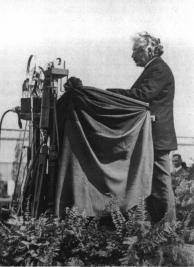“The radio has to fulfil a special and unique function for international reconciliation.”
Albert Einstein, 1930
SOUND DOCUMENT OF ALBERT EINSTEIN
On August 22 in 1930 Albert Einstein held a speech on the exhibition site at the radio tower in Berlin-Charlottenburg at the opening of the 7. Deutsche Funkausstellung und Phonoschau (7th German Radio and Audio Show) in Berlin. The speech which was broadcast via radio was held at stormy weather and near the trams rattling along in the open. Both these unfavourable circumstances and the technical imperfection of the back then sound recording are reflected in the sound quality which can be listened to here.
Despite the shortness of the sound document Einstein’s simple way of lecturing can be recognized. It is pepped up with little jokes. His slightly south German dialect can be heard well, too. Einstein received vivid applause at the end of his speech.
Sound document:
Excerpts from Albert Einstein’s speech on the occasion of the opening of the 7th German Radio and Audio Show in Berlin on August 22 in 1930. (Excerpt: 54 seconds, in German)
Courtesy of the Deutsches Rundfunkarchiv, Frankfurt on the Main.

Original text of Einstein’s speech
Those parts in the sound document which are marked blue can be listened to (in German).
“Ladies and Gentlemen who are present and who are not!
When you hear the radio think also about the fact how people have come to possess such a wonderful tool of communication. The origin of all technical achievements is the divine curiosity and the play instinct of the working and thinking researcher as well as the constructive fantasy of the technical inventor.
Think of Oersted who as the first person noticed the magnetic effect of electric currents, of Reis who as the first one made use of this effect to generate sound by using electromagnetism, of Bell who as the first person converted sound waves into variable electric currents with his microphone by using sensitive contacts. Think also of Maxwell who showed us the existence of electric waves by using a mathematical way, of Hertz who as the first person generated them with the help of a spark and thus proved them. Think especially of Liebens who invented an unprecedented measuring instrument for electric pulses, the electric valve tube. It was also an ideal and simple instrument to generate electric waves. Think gratefully of the big number of unknown engineers who simplified the instruments of communication via radio and adapted them to mass production in such a fashion that they have become ready to be used by everybody nowadays.
And everybody should be ashamed who uses the wonders of science and engineering without thinking and having mentally realized not more of it than a cow realizes of the botany of the plants which it eats with pleasure.
Think also about the fact that it is the engineers who make true democracy possible. They facilitate not only the daily work of the people but also make the works of the finest thinkers and artists accessible to the public. The pleasure of these works had recently still been a privilege of the preferred classes. Thus the engineers wake the peoples from their sleepy bluntness.
The radio has to fulfil a special and unique function for international reconciliation. Up to now peoples got to know each other almost only with the help of the distorting mirror of their own daily press. Radio shows them to each other in their most vivid form and mainly from their amicable side. Thus it will contribute to end the feeling of bilateral strangeness which so easily turns to mistrust and hostility.
With this attitude look at the results of the creation which this exhibition offers the astonished senses of the visitors.”
Original text of Einstein’s speech in German:
“Verehrte An- und Abwesende!
Wenn Ihr den Rundfunk höret, so denkt auch daran, wie die Menschen in den Besitz dieses wunderbaren Werkzeuges der Mitteilung gekommen sind. Der Urquell aller technischen Errungenschaften ist die göttliche Neugier und der Spieltrieb des bastelnden und grübelnden Forschers und nicht minder die konstruktive Phantasie des technischen Erfinders.
Denkt an Oersted, der zuerst die magnetische Wirkung elektrischer Ströme bemerkte, an Reis, der diese Wirkung zuerst benutzte, um auf elektromagnetischem Wege Schall zu erzeugen, an Bell, der unter Benutzung empfindlicher Kontakte mit seinem Mikrophon zuerst Schallschwingungen in variable elektrische Ströme verwandelte. Denkt auch an Maxwell, der die Existenz elektrischer Wellen auf mathematischem Wege aufzeigte, an Hertz, der sie zuerst mit Hilfe des Funkens erzeugte und nachwies. Gedenket besonders auch Liebens, der in der elektrischen Ventilröhre ein unvergleichliches Spürorgan für elektrische Schwingungen erdachte, das sich zugleich als ideal einfaches Instrument zur Erzeugung elektrischer Schwingungen herausstellte. Gedenket dankbar des Heeres namenloser Techniker, welche die Instrumente des Radio-Verkehres so vereinfachten und der Massenfabrikation anpassten, dass sie jedermann zugänglich geworden sind.
Sollen sich auch alle schämen, die gedankenlos sich der Wunder der Wissenschaft und Technik bedienen und nicht mehr davon geistig erfasst haben als die Kuh von der Botanik der Pflanzen, die sie mit Wohlbehagen frisst.
Denket auch daran, dass die Techniker es sind, die erst wahre Demokratie möglich machen. Denn sie erleichtern nicht nur des Menschen Tagewerk, sondern machen auch die Werke der feinsten Denker und Künstler, deren Genuss noch vor kurzem ein Privileg bevorzugter Klassen war, der Gesamtheit zugänglich und erwecken so die Völker aus schläfriger Stumpfheit.
Was speziell den Rundfunk anlangt, so hat er eine einzigartige Funktion zu erfüllen im Sinne der Völkerversöhnung. Bis auf unsere Tage lernten die Völker einander fast ausschließlich durch den verzerrenden Spiegel der eigenen Tagespresse kennen. Der Rundfunk zeigt sie einander in lebendigster Form und in der Hauptsache von der liebenswürdigen Seite. Er wird so dazu beitragen, das Gefühl gegenseitiger Fremdheit auszutilgen, das so leicht in Misstrauen und Feindseligkeit umschlägt.
Betrachtet in dieser Gesinnung die Ergebnisse des Schaffens, welche diese Ausstellung den staunenden Sinnen des Besuchers darbietet.”
Illustrations Credits:
Courtesy of the Landesarchiv Berlin


 DEUTSCH
DEUTSCH